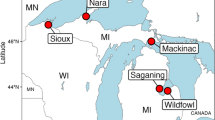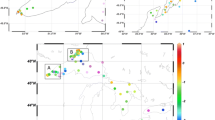Abstract
Organisms with the denitrification capacity are widely distributed and in high density in nature. It is not well understood why they are so successful. A survey of denitrifying enzyme content of various habitats is presented which indicates a role of carbon and oxygen, but not nitrate, in affecting denitrifier populations. It is suggested that organic carbon is more important than oxygen status in determining denitrifying enzyme content of habitats. In low oxygen environments, denitrifiers compete with organisms that dissimilate nitrate to ammonium, a process which conserves nitrogen. The energetic and kinetic parameters that affect this competition are evaluated. The latter is examined using Michaelis-Menten theoretical models by varying Vmax, Km, and So (substrate concentration) for the two competing populations. The outcome predicted by these models is presented and discussed in relation to previous data on population densities and Km values for representatives of these competing groups. These models suggest the conditions required to achieve changes in partitioning between the two fates of nitrate. These considerations are important if one is to be able to evaluate and successfully “manage” the fate of nitrate in any habitat.
Similar content being viewed by others
References
Bleakley, B. H. 1981. Non-denitrifying biological sources of nitrous oxide. M.S. Thesis, Michigan State Univ., E. Lansing, MI.
Burden, R. L., Faires, J. D. and Reynolds, A. C., 1978. p. 116–120 and 239–245. In Numerical analysis. — Prindle, Weber and Schmidt, Boston.
Caskey, W. H. and Tiedje, J. M. 1979. Evidence for clostridia as agents of dissimilatory reduction of nitrate to ammonium in soils. — Soil Sci. Soc. Am. J. 43: 931–936.
Caskey, W. H. and Tiedje, J. M. 1980. The reduction of nitrate to ammonium by a Clostridium sp. isolated from soil. — J. Gen. Microbiol. 119: 217–223.
Cole, J. A. and Brown, C. M. 1980. Nitrate reduction to ammonia by fermentative bacteria: a short circuit in the biological nitrogen cycle. — FEMS Microbiol. Lett. 7: 65–72.
Dunn, G. M., Herbert, R. A. and Brown, C. M. 1979. Influence of oxygen tension on nitrate reduction by Klebsiella sp. growing in chemostat culture. — J. Gen. Microbiol. 112: 379–383.
Edwards, R. M. and Tiedje, J. M. 1981. Determination of Km for dissimilatory nitrate reduction by cells of Pseudomonas fluorescens. — Abstr. Annu. Meet. Am. Soc. Microbiol. p. 181: N48.
Firestone, M. K. 1982. Biological denitrification. p. 289–326. In A. L. Page (ed.), Nitrogen in agricultural soils. Agron. Monograph No. 22. — Am. Soc. Agron., Madison.
Gamble, T. N., Betlach, M. R. and Tiedje, J. M. 1977. Numerically dominant denitrifying bacteria from world soils. — Appl. Environ. Microbiol. 33: 926–939.
Garcia, J. L. 1977. Analyse de differents groupes composant la microflore dénitrifiante des sols de rizière de Sénégal. — Ann. Microbiol. (Paris) (Inst. Pasteur) 128A: 433–446.
Garcia, J. L. and Tiedje, J. M. 1982. Denitrification in rice soils. p. 187–200. In Y. Dommergues and H. Diem (eds), Microbiology of tropical soils and plant productivity. — Martinus Nijhoff Publ., The Hague, In press.
Healey, F. P. 1980. Slope of Monod equation as an indicator of advantage in nutrient competition. — Microb. Ecol. 5: 281–286.
Kaspar, H. F. 1982. Denitrification in marine sediment: measurement of capacity and estimate of in situ rate. — Appl. Environ. Microbiol. 43: 522–527.
Kaspar, H. F. and Tiedje, J. M. 1981. Dissimilatory reduction of nitrate and nitrite in the bovine rumen: nitrous oxide production and effect of acetylene. — Appl. Environ. Microbiol. 41: 705–709.
Kaspar, H. F., Tiedje, J. M. and Firestone, R. B. 1981. Denitrification and dissimilatory nitrate reduction to ammonium in digested sludge. — Can. J. Microbiol. 27: 878–885.
Keeney, D. R., Chen, R. L. and Graetz, D. A. 1971. Importance of denitrification and nitrate reduction in sediments to the nitrogen budgets of lakes. — Nature 233: 66–67.
Koike, J. and Hattori, A. 1978. Denitrification and ammonia formation in anaerobic coastal sediments. — Appl. Environ. Microbiol. 35: 278–282.
Okereke, G. U. 1978. Utilization and production of N2O by denitrifiers isolated from different soil environments and effect of pH on the rates and products of denitrification. — M.S. Thesis, Michigan State Univ., E. Lansing.
Payne, W. J. 1981. Denitrification. — John Wiley and Sons, New York.
Payne, W. J. and Balderston, W. L. 1978. Denitrification. p. 339–342. In D. Schlessinger (ed.), Microbiology 1978. — Am. Soc. Microbiol, Washington.
Rao, K. P. and Rains, D. W. 1976. Nitrate absorption by barley I. Kinetics and energetics. —Plant Physiol. 57: 55–58.
Reddy, K. R., Patrick, W. H. and Phillips, R. E. 1980. Evaluation of selected processes controlling nitrogen losses in a flooded soil. — Soil Sci. Soc. Am. J. 44: 1241–1246.
Smith, K. A. 1980. A model of the extent of anaerobic zones in aggregrated soils, and its potential application to estimates of denitrification. — J. Soil Sci. 31: 263–277.
Smith, M. S. and Tiedje, J. M. 1979. Phases of denitrification following oxygen depletion in soil. — Biol. Biochem. 11: 261–267.
Smith, M. S. and Tiedje, J. M. 1980. Growth and survival of antibiotic-resistant denitrifier strains in soil. — Can. J. Microbiol. 26: 854–856.
Smith, M. S. and Zimmerman, K. 1981. Nitrous oxide production by nondenitrifying soil nitrate reducers. — Soil Sci. Soc. Am. J. 45: 865–871.
Sørensen, J. 1978. Capacity for denitrification and reduction of nitrate to ammonia in a coastal marine sediment. — Appl. Microbiol. 35: 301–305.
Thauer, R. K., Jungmann, K and Decker, K. 1977. Energy conservation in chemotrophic anaerobic bacteria. — Bacteriol. Rev. 41: 100–180.
Van't Riet, J. and Planta, R. J. 1969. Purification and some properties of the membrane-bound respiratory nitrate reductase of Aerobacter aerogenes. — FEBS Lett. 5: 249–252.
Author information
Authors and Affiliations
Additional information
Published as Jornal Article No. 10598 of the Michigan Agricultural Experiment Station. The authors acknowledge the National Science Foundation for research grant support.
Rights and permissions
About this article
Cite this article
Tiedje, J.M., Sexstone, A.J., Myrold, D.D. et al. Denitrification: ecological niches, competition and survival. Antonie van Leeuwenhoek 48, 569–583 (1983). https://doi.org/10.1007/BF00399542
Received:
Issue Date:
DOI: https://doi.org/10.1007/BF00399542




